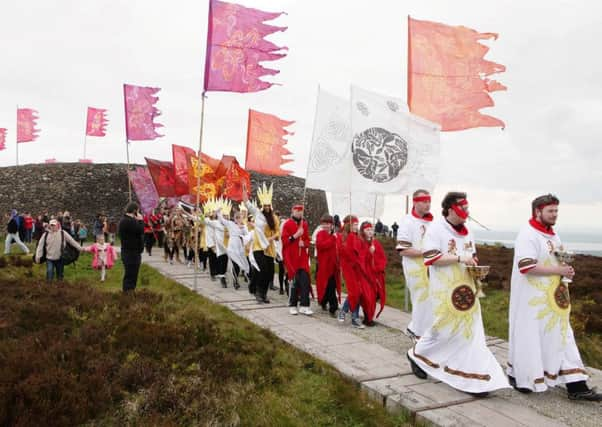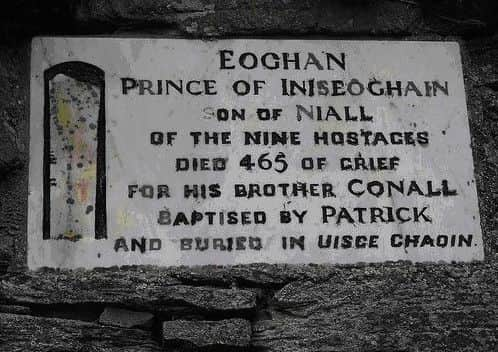Grianán the ancestral home of all who claim Derry & Inishowen roots


I tell overseas visitors and researchers, with a connection to North West Ireland, to visit Grianán Fort as it is in effect the ancestral birthplace of those people with origins in Counties Derry, Donegal and Tyrone.
Grianán of Aileach, with its panoramic views over Loughs Foyle and Swilly and the surrounding countryside, was built here as a symbol of royal power. This large stone-walled fort was the royal citadel of the northern Uí Néill from the fifth to the twelfth century. Three earthen banks circle the Grianán which may be part of an earlier Bronze Age or Iron Age hillfort.
Derry and Donegal surnames


Advertisement
Hide AdAdvertisement
Hide AdMany of the prominent surnames in Counties Derry, Donegal and Tyrone today trace their descent from Niall of the Nine Hostages, and, in particular, from two of his sons Eoghan and Conall Gulban who conquered North West Ireland about 425 A.D., and in the process captured Grianán of Aileach, which commanded the entrance to the Inishowen peninsula.
By tradition, St. Patrick converted Eoghan, King of Aileach, and his people to Christianity in 443 AD at the royal palace of Grianán of Aileach.
Those tracing descent from Eoghan include: Brolly, Carlin, Devlin, Donnelly, Duddy, Duffy, Farren, Gormley, Hegarty, McCloskey, McLaughlin, Mellon, Mullen, O’Hagan, O’Kane, O’Neill, Quinn and Toner. From Conall Gulban: Doherty, Friel, Gallagher, McCafferty, McDaid, McDevitt and O’Donnell.
St Patrick’s Church, Iskaheen
The plaque marking the reputed burial place of Eoghan can be seen today at St. Patrick’s Roman Catholic Church, Iskaheen (in Gaelic Uisce Chaoin), near the village of Muff in Inishowen, County Donegal, and commanding the most magnificent view of Lough Foyle.
Advertisement
Hide AdAdvertisement
Hide AdThe Gaelic name is frequently translated directly as calm or clear water. The area is steeped in history.
According to ‘The Annals of Four Masters’, Eoghan, son of Niall of the Nine Hostages, who died in 465, is buried in Iskaheen. In the mid-1970s a plaque commemorating this was erected on the ivy gable (seventeenth century ruins marking the site of an ancient fifth century abbey) at the entrance to the old graveyard.
The exact location of the grave is unknown. It is thought that Eoghan came to Inshowen around 386 AD, and it is Eoghan that gives Inishowen its name, i.e. the island of Eoghan. Old poems tell that Eoghan’s youngest son was drowned in the Foyle and buried here because there was such a splendid view of the Foyle. It is also claimed that the river Foyle got its name from this son, Feral or Foible.
DNA
Geneticists at Trinity College claim that “up to three million men around the world” and as many as one in 12 Irishmen, and as high as one in 5 people in North West of Ireland - Counties Derry, Donegal and Tyrone - are descended from a common ancestor who “was likely to have lived about 1,700 years ago”.
Advertisement
Hide AdAdvertisement
Hide AdThis concentration in the North West, together with the time factor pointed, in the eyes of the researchers at Trinity College, to the Uí Néill dynasty. Uí Néill means ‘descendants of Niall’; Niall being Niall of the Nine Hostages, High King of Ireland from 379 to 405 AD.
Partholón myth
Seathrún Céitinn, in his pseudo-history, ‘Foras Feasa ar Éirinn’, relates the myth of how Partholón, arriving from Thrace 300 hundred years after the flood, used Grianán as a marker when dividing Ireland between his four sons.
“He gave the first part to Er, namely, all that is from Aileach Néid in the north of Ulster to Athcliath of Leinster. He gave the second part to Orba, namely, all that is from Athcliath to Oiléan Arda Neimheadh, which is called Oiléan Mór an Bharraigh. He gave the third part to Fearon, from the Great Island to Athcliath Meadhruidhe at Galway. He gave the fourth part to Feargna, namely, from Meadhruidhe to Aileach Néid,” he recorded.